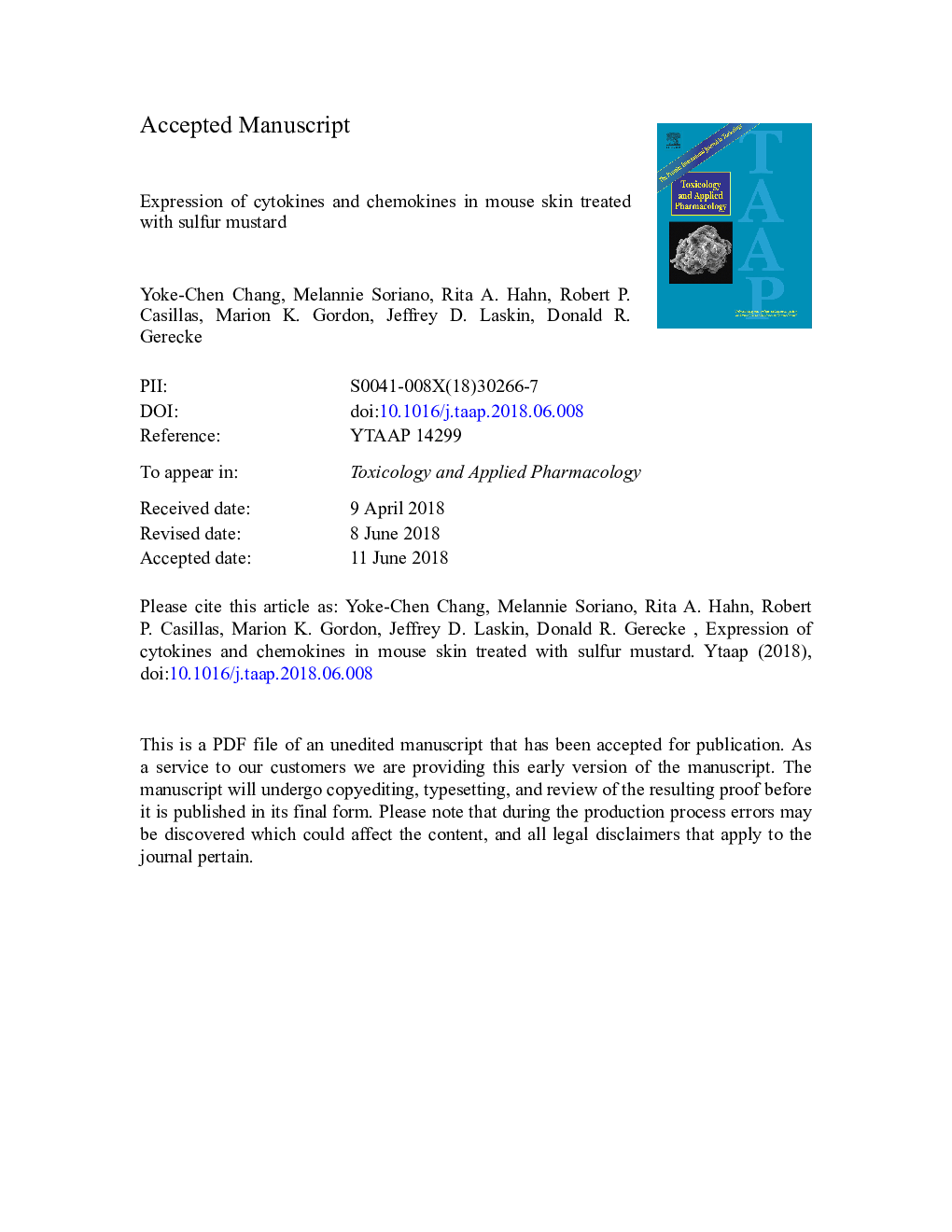| کد مقاله | کد نشریه | سال انتشار | مقاله انگلیسی | نسخه تمام متن |
|---|---|---|---|---|
| 8538071 | 1561107 | 2018 | 37 صفحه PDF | دانلود رایگان |
عنوان انگلیسی مقاله ISI
Expression of cytokines and chemokines in mouse skin treated with sulfur mustard
ترجمه فارسی عنوان
بیان سیتوکین ها و کومکوکان ها در پوست ماوس درمان شده با گوگرد خردل
دانلود مقاله + سفارش ترجمه
دانلود مقاله ISI انگلیسی
رایگان برای ایرانیان
کلمات کلیدی
CCL2/MCP-1VesicantsMMP12IFN-γ-inducible protein 10MPO - DFODermal toxicity - سمیت پوستSulfur mustard - سولفور موستارد یا گاز خردلGranulocyte-colony stimulating factor - فاکتور تحریک گرانولیسیت کلنیmyeloperoxidase - میلوپراکسیداز Inflammatory mediators - واسطه های التهابیmonocyte chemoattractant protein 1 - پروتئین cheoattractant monocyte 1Macrophage inflammatory protein 1α - پروتئین التهابی مکررا 1α
موضوعات مرتبط
علوم زیستی و بیوفناوری
علوم محیط زیست
بهداشت، سم شناسی و جهش زایی
چکیده انگلیسی
Sulfur mustard (2,2â²-dichlorodiethyl sulfide, SM) is a chemical warfare agent that generates an inflammatory response in the skin and causes severe tissue damage and blistering. In earlier studies, we identified cutaneous damage induced by SM in mouse ear skin including edema, erythema, epidermal hyperplasia and microblistering. The present work was focused on determining if SM-induced injury was associated with alterations in mRNA and protein expression of specific cytokines and chemokines in the ear skin. We found that SM caused an accumulation of macrophages and neutrophils in the tissue within one day which persisted for at least 7â¯days. This was associated with a 2-15 fold increase in expression of the proinflammatory cytokines interleukin-1β, interleukin-6, and tumor necrosis factor α at time points up to 7â¯days post-SM exposure. Marked increases (20-1000 fold) in expression of chemokines associated with recruitment and activation of macrophages were also noted in the tissue including growth-regulated oncogene α (GROα/CXCL1), monocyte chemoattractant protein 1 (MCP-1/CCL2), granulocyte-colony stimulating factor (GCSF/CSF3), macrophage inflammatory protein 1α (MIP1α/CCL3), and IFN-γ-inducible protein 10 (IP10/CXCL10). The pattern of cytokines/chemokine expression was coordinate with expression of macrophage elastase/MMP12 and neutrophil collagenase/MMP8 suggesting that macrophages and neutrophils were, at least in part, a source of cytokines and chemokines. These data support the idea that inflammatory cell-derived mediators contribute to the pathogenesis of SM induced skin damage. Modulating the infiltration of inflammatory cells and reducing the expression of inflammatory mediators in the skin may be an important strategy for mitigating SM-induced cutaneous injury.
ناشر
Database: Elsevier - ScienceDirect (ساینس دایرکت)
Journal: Toxicology and Applied Pharmacology - Volume 355, 15 September 2018, Pages 52-59
Journal: Toxicology and Applied Pharmacology - Volume 355, 15 September 2018, Pages 52-59
نویسندگان
Yoke-Chen Chang, Melannie Soriano, Rita A. Hahn, Robert P. Casillas, Marion K. Gordon, Jeffrey D. Laskin, Donald R. Gerecke,
